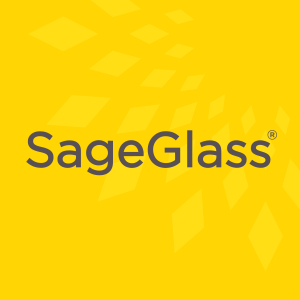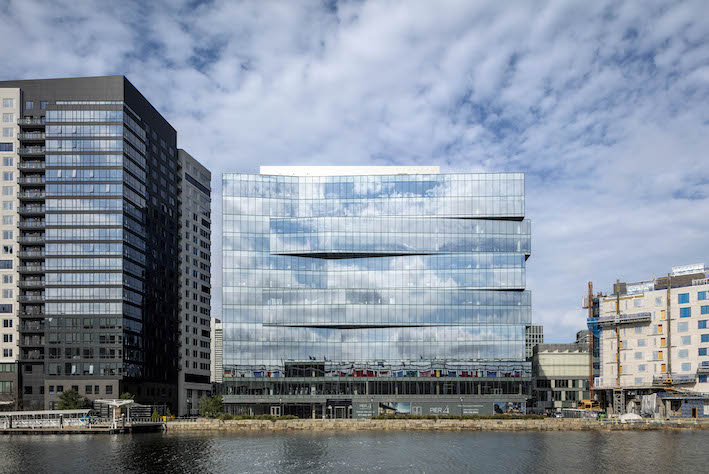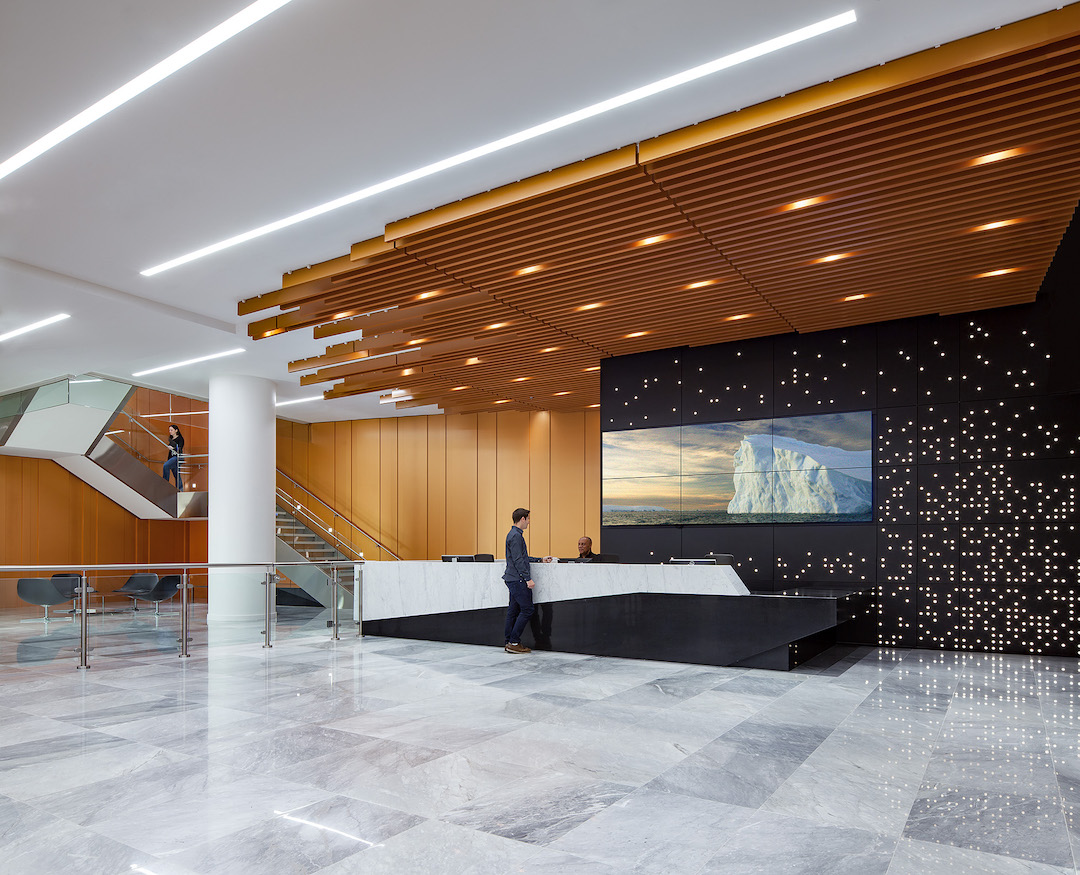Corporate space consolidation and the need to upgrade the employee experience will keep the office market fairly strong for the next 18 months before the sector taps the brakes. “I don’t think it will be anything dramatic, but I think there will be a leveling,” says Dennis Cornick, EVP, Gilbane Building Company. Construction costs and a slackening demand for space built on spec will dampen the market, he says.
In the last year, open office design has come under attack by Harvard Business School. Recent HBS studies found that when employees moved from a traditional office setting to an open office, collaboration actually declined. Many workers plugged wireless devices in their ears to tune out office noise—and their co-workers. The studies have prompted designers and real estate decision makers to rethink the open-office trend.
 The 2019 Office Giants Report is sponsored by SageGlass. Also check out these 2019 Office Sector rankings, brought to you by SageGlass:
The 2019 Office Giants Report is sponsored by SageGlass. Also check out these 2019 Office Sector rankings, brought to you by SageGlass:
• Top 200 Office Sector Architecture Firms
• Top 100 Office Sector Engineering Firms
• Top 110 Office Sector Construction Firms
“I’ve heard different opinions from different clients,” says Cornick. Some open office projects have been successful, he says; others have not fostered the expected level of collaboration. Nonetheless, he says, “The drive for more collaboration and teamwork is almost a universal desire.”
With no universally accepted formula for office design, major redesigns should be preceded by “a robust process to understand the use of space” and employee habits, says Lise Newman, AIA, Vice President, National Workplace Director, SmithGroup.
SmithGroup looks for a blend of settings for three work modes: “focus, collaborate, and create.” Small rooms are for taking calls or writing reports. Larger rooms are for team activities—meetings and presentations. Open space may be appropriate for most other activities. The number and size of quiet rooms and of collaboration space vary from client to client.
The “WeWork factor” is also figuring prominently in office projects, says Gilbane Vice President Ryan Hutchins. WeWork is outfitting space with a rich menu of amenities for such clients as Citi, Microsoft, and BlackRock. WeWork’s mix of private, open, and event space is replete with sofas, café counters, and a hip vibe. Other developers and owners are being forced to up their game to compete for the most desirable tenants.
In the war for top talent, particularly technology talent, the working environment is increasingly part of the competitive landscape. “To be innovative, you have to get the best people,” Newman says. “Even traditional businesses like banking compete with Silicon Valley for talent.” When a company like Google creates a new outdoor amphitheater for movie screenings, as it did at its Ann Arbor, Mich., location, it raises the bar. For some talented prospects, a cool, Google-like workspace can tip the scales when evaluating offers from multiple employers.
Office developers, architects focus on workplace amenities
Developers are creating shared amenities to address this trend at multi-tenant sites. Shared work cafés offer the sense that “you are not stuck in an open office,” Newman says. With increased use of mobile technology, many workers want a choice of indoor and outdoor work spaces. Commercial-grade kitchens and feature-rich fitness centers that might include basketball courts and squash courts are on the amenity wish list for some clients, Newman adds. “The convergence of pleasure with work is here to stay,” she says.
Employers and designers are looking to technology to improve work efficiency, space usage, occupant comfort, and security. Analytics can help companies understand workspace demand, says Val Loh, Principal, Syska Hennessy Group. If an organization learns that 10% of employees work outside the office every day, it can cut office space by 10% and slash real estate costs. “In a major metro area, that’s a substantial amount,” Loh says.
Continued improvement in the performance of wireless technology has prompted some clients to raise the possibility of a totally wireless data environment. Loh warns that the technology is not yet reliable enough for that. “We still recommend at least one wire per workstation,” he says, even for non-mission-critical systems.
 Pier 4 office building, Boston, designed by Elkus Manfredi Architects. Photo: Magda Biernat Photography
Pier 4 office building, Boston, designed by Elkus Manfredi Architects. Photo: Magda Biernat Photography
Loh recalls one pharmaceutical client that wanted to go 100% wireless. Syska Hennessy convinced the client to stick with the one-wire-per-desk protocol. It turned out that many of the company’s laptops were not compatible with the latest wireless networking. The wired option saved the company from paying for an immediate wholesale replacement of older laptops.
Mobile technology can enhance the work environment by allowing employees to reserve workspaces, change light settings, adjust heating and cooling at their workstations, arrange valet parking, dry cleaning, and provide mass transit updates.
Technology also offers new security tools. Cameras with video analytics can warn security personnel about unattended bags and packages, unauthorized people loitering around secure facilities, and suspicious vehicles.
Cameras, perhaps combined with palm or fingerprint recognition systems, might some day replace keycards and fobs for access control, says Loh. Workers at many high-rise office buildings have to carry two cards—one to enter the main lobby, another to get into their offices. In the future, video analytics and handprint systems could eliminate the need for any keycards.
HIGH-RISE MASS TIMBER CATCHING ON in office sector
The Class A office sector has become an early adopter of high-rise mass timber as the critical structural component. “Many of the first mass timber projects in the U.S. are offices because the 2015 IBC code already has a path for them,” says Chris Evans, Director, Swinerton Mass Timber, a spinoff of construction giant Swinerton. Most U.S. mass timber projects to date have been on the West Coast, close to cross-laminated timber suppliers, but a new CLT facility is coming online in a converted 227,000-sf General Electric facility in Dothan, Ala.
Mass timber structures offer the potential to save about 15% on the construction schedule and have a lighter superstructure than concrete. “Once you have the floor installed, trades can start working below,” says Evans. “There is no shoring system needed. You can start four to six weeks earlier compared to a post-tensioned system.”
Being lighter than concrete means reduced earthwork and foundation work, he adds. Some sites that may not have the bearing for concrete structures without extraordinary engineering measures may be able to support a mass timber structure. Exposed wood beams add a biophilic aesthetic to interior spaces. “Design firms love it,” Evans says.
Mass timber visionaries keep looking to build higher. A developer in Vancouver recently proposed a 35-40-story tower with a mass timber frame and concrete core. For now, the sweet spot is up to six stories, says Evans. “We see a lot of 120,000 to 300,000 sf projects that are five or six stories high,” he says.
Evans is convinced that mass timber will continue to attract converts, especially in the office market. “We believe that it will not be a niche market,” he says. “In the future, this is how many projects will be built, whether beams are exposed or not.”
MORE FROM BD+C'S 2019 GIANTS 300 REPORT
Related Stories
Construction Costs | Apr 18, 2024
New download: BD+C's April 2024 Market Intelligence Report
Building Design+Construction's monthly Market Intelligence Report offers a snapshot of the health of the U.S. building construction industry, including the commercial, multifamily, institutional, and industrial building sectors. This report tracks the latest metrics related to construction spending, demand for design services, contractor backlogs, and material price trends.
MFPRO+ New Projects | Apr 16, 2024
Marvel-designed Gowanus Green will offer 955 affordable rental units in Brooklyn
The community consists of approximately 955 units of 100% affordable housing, 28,000 sf of neighborhood service retail and community space, a site for a new public school, and a new 1.5-acre public park.
Construction Costs | Apr 16, 2024
How the new prevailing wage calculation will impact construction labor costs
Looking ahead to 2024 and beyond, two pivotal changes in federal construction labor dynamics are likely to exacerbate increasing construction labor costs, according to Gordian's Samuel Giffin.
Healthcare Facilities | Apr 16, 2024
Mexico’s ‘premier private academic health center’ under design
The design and construction contract for what is envisioned to be “the premier private academic health center in Mexico and Latin America” was recently awarded to The Beck Group. The TecSalud Health Sciences Campus will be located at Tec De Monterrey’s flagship healthcare facility, Zambrano Hellion Hospital, in Monterrey, Mexico.
Market Data | Apr 16, 2024
The average U.S. contractor has 8.2 months worth of construction work in the pipeline, as of March 2024
Associated Builders and Contractors reported today that its Construction Backlog Indicator increased to 8.2 months in March from 8.1 months in February, according to an ABC member survey conducted March 20 to April 3. The reading is down 0.5 months from March 2023.
Laboratories | Apr 15, 2024
HGA unveils plans to transform an abandoned rock quarry into a new research and innovation campus
In the coastal town of Manchester-by-the-Sea, Mass., an abandoned rock quarry will be transformed into a new research and innovation campus designed by HGA. The campus will reuse and upcycle the granite left onsite. The project for Cell Signaling Technology (CST), a life sciences technology company, will turn an environmentally depleted site into a net-zero laboratory campus, with building electrification and onsite renewables.
Codes and Standards | Apr 12, 2024
ICC eliminates building electrification provisions from 2024 update
The International Code Council stripped out provisions from the 2024 update to the International Energy Conservation Code (IECC) that would have included beefed up circuitry for hooking up electric appliances and car chargers.
Urban Planning | Apr 12, 2024
Popular Denver e-bike voucher program aids carbon reduction goals
Denver’s e-bike voucher program that helps citizens pay for e-bikes, a component of the city’s carbon reduction plan, has proven extremely popular with residents. Earlier this year, Denver’s effort to get residents to swap some motor vehicle trips for bike trips ran out of vouchers in less than 10 minutes after the program opened to online applications.
Laboratories | Apr 12, 2024
Life science construction completions will peak this year, then drop off substantially
There will be a record amount of construction completions in the U.S. life science market in 2024, followed by a dramatic drop in 2025, according to CBRE. In 2024, 21.3 million sf of life science space will be completed in the 13 largest U.S. markets. That’s up from 13.9 million sf last year and 5.6 million sf in 2022.
Multifamily Housing | Apr 12, 2024
Habitat starts leasing Cassidy on Canal, a new luxury rental high-rise in Chicago
New 33-story Class A rental tower, designed by SCB, will offer 343 rental units.

















